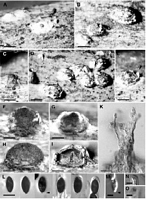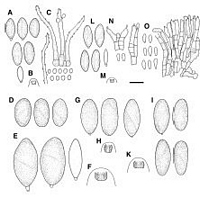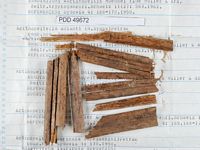|
 Astrocystis cyatheae Astrocystis cyatheae
BiostatusPresent in region - Indigenous. Endemic
Images (click to enlarge)
Caption: Fig. 1 Astrocystis cyatheae. A-H, Stromata, A-G with white covering of
host epidermis, E,
stellately split host epidermis (arrow); I, Vertical section of stroma, note stroma shell with
detached perit | 
Caption: Fig. 2 A-C, Astrocystis cyatheae, PDD 49673: A, Ascospores, the lowest immature (1st, 2nd
from type, PDD 49672); B, Ascus apical ring; C, Conidiophores and conidia on the stroma
(PDD 42074); D, H. aucklandi | 
Caption: Dried type specimen
Owner: Herb PDD |
Article: Petrini, L.E. (2003). Rosellinia and related genera in New Zealand. New Zealand Journal of Botany 41(1): 71-138 (http://www.rsnz.org/publish/abstracts.php).
Description: Stromata breaking through the host epidermis, splitting it in a stellate manner (Fig. 1E),
exposing the conidial state as white tufts, sometimes with host epidermis attached to its
surface as white scales at an early stage. Stromata (375)438 ± 43(500) µm high, (500)657 ±
75(750) µm wide (n = 10), cylindrical to conical with almost flattened top, initially appearing
white to light brown due to the attached host epidermis, black when fully emerged, with
smooth surface, solitary. Ostioles finely papillate. Ectostroma 25-50 µm thick. Entostroma not
seen. Perithecia detached and collapsed in mature material. Ascus apical rings (2.4)2.7 ±
0.2(2.8) µm high, upper width 2.8-4 µm, lower width 1.9- 2.8 µm (n = 6), without bulge at
upper margin, J+, pale blue. Ascospores (13)14.6 ± 0.8(16.8) µm long, (6.7)7.5 ± 0.3(8.2) µm
wide ( n = 45), inequilaterally ellipsoidal, dark brown, with straight germ slit, running over
the whole spore length, some ascospores with a basal, 1 x 1 µm large, cellular appendage.
Conidiophores variable in length, 2.5-5 µm in width, hyaline to light brown at base, as white
tufts on young stromata, arising from parenchymatous cell tissue. Conidia 3-4 x 3 µm (n =
10), globose, hyaline to light brown.
ANAMORPH: Acanthodochium.
Habitat: HOST: Cyathea dealbata.
MATRIX: Rachides.
Notes: ETYMOLOGY: Referring to the host plant, Cyathea spp.
NOTES: Astrocystis cyatheae has non-splitting stromata and is characterised by ascospores
with a cellular appendage. No stromatic remnants were detectable on the host epidermis
folded away, as described for other Astrocystis species with splitting stromata such as A.
mirabilis Berk. & Broome. On very young stromata the anamorph was observed as white to
cream tufts. Its morphology corresponds to Acanthodochium.
That a fern is the host for this Astrocystis species is remarkable, as all other species of this
genus are known from monocotyledons. So far, xylariaceous fungi have not been reported on
pteridophytes (Rogers 1979).
Astrocystis species with a spore size roughly similar to that of A. cyatheae and non-splitting
stromata are A. hughesii Læssøe & Spooner, A. palmarum Læssøe & Spooner, A. rachidis
(Pat.) K.D.Hyde & J.Fröhlich, Astrocystis selangorensis G.J.D.Smith & K.D.Hyde, and
Rosellinia albocincta Petch. Astrocystis hughesii has smaller stromata and ascospores with a
shorter germ slit that is less than spore length. Astrocystis palmarum has much larger stromata
and ascospores lacking an appendage. Astrocystis rachidis has smaller ascospores without an
appendage and smaller ascus apical rings. Astrocystis selangorensis has larger ascospores with
a cellular appendage, and its stromata are softwalled; the ascus apical rings are also larger
(Smith & Hyde 2001). Rosellinia albocincta Petch has larger stromata and smaller ascospores
without appendages.
|